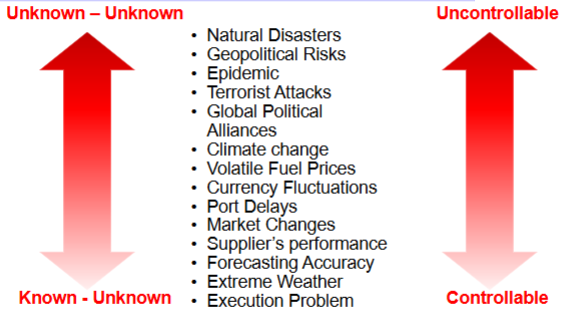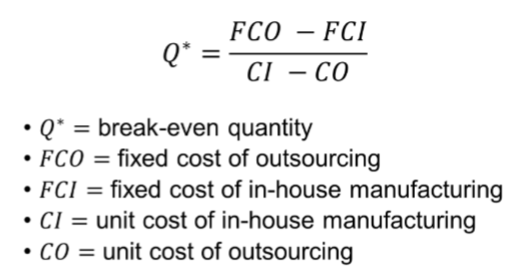Lecture 6a_Insourcing vs Outsourcing
1/27
There's no tags or description
Looks like no tags are added yet.
Name | Mastery | Learn | Test | Matching | Spaced |
|---|
No study sessions yet.
28 Terms
Efficient Supply chains
Designed for efficiency and low cost by minimizing inventory and maximizing efficiencies in process flows:
Goods/services with highly predictable demand
Stable product lines with long life cycles
Low contribution margins
Responsive Supply chains
Focus on Flexibility and responsive service
Demand is unpredictable
Short product life cycles
Fast response is main competitive priority
Customers require high customization
High contribution margin
Push system
Produces goods in advance of customer demand using a forecast and stores them as finished goods
Immediate availability of goods to customers
Reduce transportation costs through full truckload shipments
Pull system:
Produces only what is needed in responses to customers demand signals
Minimizes inventory and production costs
Postponement:
Delaying product customization until the product is closer to the customer at the end of the supply chain
Availability of information and communication has made international trade easier
Call Centers for US customers located in India
Developing countries represent opportunities for cost savings and new markets.
China and India are two well-known examples
Regions such as Africa and South East Asia represent new opportunities
Outsourcing and offshoring
Searching for low-cost labor – foreign operations
Searching for low-cost raw materials – foreign suppliers
Access to resources
International supply chains
Supply, production, and distribution take place at various facilities location around the world
Vertical Integration
The process of acquiring and consolidating elements of a value chain to achieve more control
Typically adds managerial complexity
Backward integration
Acquiring capabilities towards suppliers
Forward integration
Acquiring capabilities toward distribution (or customers)
Opposite is sourcing
Reduces control and increases risks.
Forces Shaping Global SC Decisions
Market forces
Higher than expected demand for new products
Competition
Technological forces
New technology like blockchain
Global cost forces
Lower labor costs, raw materials costs
Political and macroeconomic forces
Exchange rates, trade agreements, tariffs, export restrictions, political instability
Risk sources and Their characteristics


Decisions on where to operate or who to source from impact every aspect of the SC
• Sourcing
• Manufacturing
• Transportation
• Distribution
Bottom Line:
Consider the total cost of ownership

Many firms purchase internationally
International trade complexity
Logistical differences
Longer Supply Chain
Global Sourcing
Access to raw materials (e.g.: cocoa in Ivory Coast, cobalt in Congo)
Low-cost skilled labor
Economic factors (e.g.: tax breaks, low trade tariffs)
Global Sourcing
Potential Advantages
Cost (scale, labor, material, etc.)
Create a presence in a region/ country
Competition for domestic suppliers
Access to scarce materials, products, or parts
Quality advantages in specific locations
Technology and innovation
Currency and other financial considerations
Global Sourcing
Barriers
Security
Ethical issues
Lead time and other supply chain issues
Higher transportation costs
Currency fluctuation
Legal/ Governmental issues
Regulatory differences
Internal Communication
Supplier capability in certain locations
Global Manufacturing
Shrinking the supply chain
End consumers in a foreign country
Manufacturing customers
Potential cost advantages
Raw material & energy
Investment, economic/tax incentives
Industry clusters
Specialized labor
Government incentives
Global Manufacturing
Potential Issues
Factory setup
Government regulations
Environmental, safety, financial
Worker education & skill levels
Cultural issues
Infrastructure and Technology
Distribution complexity
Longer Lead times
Global Transportation
Potential I
Lead time requirements
Transport mode
Volume
Weight
Value
Customs
Tariffs
Local infrastructure
Starting a Global Supply Chain
Domestic → Regional → Global
Going from a domestics to a global scale can be extremely complex
Going from domestics to regional or “mega” regional can be a good compromise
Start in a country that you have existing resources if possible
Developed countries are good first step
Considering just the direct costs can get companies in trouble... fast
Organization must consider potential risks in their supply chain and take “TOTAL COST” Approach
Plant efficiency
Worker Productivity
Quality
Transportation differences
Raw materials vs Finished Gôds
Infrastructure
Cost of Emergency shipments
Political stability
Acts of God
Starting a Global Supply Chain Recent trends
With rising labor costs in China
Companies are moving to Southeast Asia
Companies are moving to Latin America
Companies are near-shoring
Moving production closer to end markets
Improve service levels
Reduce inventory in transit
Increase control over product quality
Companies are reshoring
Returning to home country
Break-Even Analysis for Outsourcing Decisions

A firm is evaluating the alternative of manufacturing a part that is currently
being outsourced from a supplier. For an in-house manufacturing, the annual
fixed cost is $45,000 and the unit cost per part is $130. Currently the unit cost
of purchasing the part from the supplier is $160. The demand forecast is 1200
units
a) Compute the cost of manufacturing in-house and outsourcing. What decision should the firm make?
b) Determine the break-even quantity for which the firm would be indifferent between manufacturing the part in-house or outsourcing it
c) What is the maximum price per part the manufacturer should be willing to pay to the supplier if the forecast is 800 parts?
a) Compute the cost of manufacturing in-house and outsourcing. What decision should the firm make?
Cin-house = FCI + CI x Q = 45000 + 130 x 1200 = 201,000
Coutsource = FCO + CO x Q = 0 + 160 x 1200 = 192,000
The firm should outsource
b) Determine the break-even quantity for which the firm would be indifferent between manufacturing the part in-house or outsourcing it
Q* = (FCO – FCI)/(CI-CO) = (0-45000)/(130-160) = 1500
c) What is the maximum price per part the manufacturer should be willing to pay to the supplier if the forecast is 800 parts?
Cin-house = FCI + CI x Q = 45000 + 130 x 800 = 149,000
Coat 800 units = 149,000/800 = $186.25
The firm is willing to pay under $186.25 per unit for outsourcing